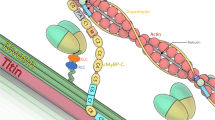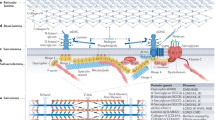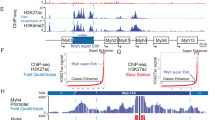Abstract
The genetic basis of most conditions characterized by congenital contractures is largely unknown. Here we show that mutations in the embryonic myosin heavy chain (MYH3) gene cause Freeman-Sheldon syndrome (FSS), one of the most severe multiple congenital contracture (that is, arthrogryposis) syndromes, and nearly one-third of all cases of Sheldon-Hall syndrome (SHS), the most common distal arthrogryposis. FSS and SHS mutations affect different myosin residues, demonstrating that MYH3 genotype is predictive of phenotype. A structure-function analysis shows that nearly all of the MYH3 mutations are predicted to interfere with myosin's catalytic activity. These results add to the growing body of evidence showing that congenital contractures are a shared outcome of prenatal defects in myofiber force production. Elucidation of the genetic basis of these syndromes redefines congenital contractures as unique defects of the sarcomere and provides insights about what has heretofore been a poorly understood group of disorders.
This is a preview of subscription content, access via your institution
Access options
Subscribe to this journal
Receive 12 print issues and online access
$209.00 per year
only $17.42 per issue
Buy this article
- Purchase on Springer Link
- Instant access to full article PDF
Prices may be subject to local taxes which are calculated during checkout



Similar content being viewed by others
Accession codes
Accessions
GenBank/EMBL/DDBJ
References
Bamshad, M., Bohnsack, J.F., Jorde, L.B. & Carey, J.C. Distal arthrogryposis type 1: clinical analysis of a large kindred. Am. J. Med. Genet. 65, 282–285 (1996).
Bamshad, M., Jorde, L.B. & Carey, J.C. A revised and extended classification of the distal arthrogryposes. Am. J. Med. Genet. 65, 277–281 (1996).
Hall, J.G., Reed, S.C. & Greene, G. The distal arthrogryposes: delineation of new entities - review and nosologic discussion. Am. J. Med. Genet. 11, 185–239 (1982).
Krakowiak, P.A. et al. A variant of Freeman-Sheldon syndrome maps to 11p15.5-pter. Am. J. Hum. Genet. 60, 426–432 (1997).
Freeman, E.A. & Sheldon, J.H. Cranio-carpo-tarsal dystrophy: an undescribed congenital malformation. Arch. Dis. Child. 13, 277 (1938).
Hall, J.G. Arthrogryposes. in Principles and Practice of Medical Genetics (eds. Emery, A.E.H. & Rimoin, D.L.) 989–1035 (Churchill Livingstone, Edinburgh, 1992).
Burian, F. The “whistling face” characteristic in a compound cranio-facio-corporal syndrome. Br. J. Plast. Surg. 16, 140–143 (1963).
Stevenson, D.A. et al. Clinical characteristics and natural history of Freeman-Sheldon syndrome. Pediatr. 117, 754–762 (2006).
Sung, S.S. et al. Mutations in genes encoding fast-twitch contractile proteins cause distal arthrogryposis syndromes. Am. J. Hum. Genet. 72, 681–690 (2003).
Sung, S.S. et al. Mutations in TNNT3 cause multiple congenital contractures: a second locus for distal arthrogryposis type 2B. Am. J. Hum. Genet. 73, 212–214 (2003).
Veugelers, M. et al. Mutation of perinatal myosin heavy chain associated with a Carney complex variant. N. Engl. J. Med. 351, 460–469 (2004).
Allingham, J.S., Smith, R. & Rayment, I. The structural basis of blebbistatin inhibition and specificity for myosin II. Nat. Struct. Mol. Biol. 12, 378–379 (2005).
Wallgren-Pettersson, C. et al. Genotype-phenotype correlations in nemaline myopathy caused by mutations in the genes for nebulin and skeletal muscle α-actin. Neuromuscul. Disord. 14, 461–470 (2004).
Agrawal, P.B. et al. Heterogeneity of nemaline myopathy cases with skeletal muscle α-actin gene mutations. Ann. Neurol. 56, 86–96 (2004).
Seidman, J.G. & Seidman, C. The genetic basis for cardiomyopathy: from mutation identification to mechanistic paradigms. Cell 104, 557–567 (2001).
Richard, P. et al. Hypertrophic cardiomyopathy: distribution of disease genes, spectrum of mutations, and implications for a molecular diagnosis strategy. Circulation 107, 2227–2232 (2003).
Tajsharghi, H. et al. Myosin storage myopathy associated with a heterozygous missense mutation in MYH7. Ann. Neurol. 54, 494–500 (2003).
Meredith, C. et al. Mutations in the slow skeletal muscle fiber myosin heavy chain (MYH7) cause Laing early onset distal myopathy (MPD1). Am. J. Hum. Genet. 75, 703–708 (2004).
Martinsson, T. et al. Autosomal dominant myopathy: Missense mutation (Glu-706 3 Lys) in the myosin heavy chain IIa gene. Proc. Natl. Acad. Sci. USA 97, 14614–14619 (2000).
Karsch-Mizrachi, I., Travis, M., Blau, H. & Leinwald, L.A. Expression and DNA sequence analysis of a human embryonic skeletal muscle myosin heavy chain gene. Nucleic Acids Res. 17, 6167–6179 (1989).
Eller, M. et al. Human embryonic myosin heavy chain cDNA. Interspecies sequence conservation of the myosin rod, chromosomal locus and isoform specific transcription of the gene. FEBS Lett. 256, 21–28 (1989).
Wells, L., Edwards, K.A. & Bernstein, S.I. Myosin heavy chain isoforms regulate muscle function but not myofibril assembly. EMBO J. 15, 4454–4459 (1996).
Swank, D.M. et al. Alternative exon-encoded regions of Drosophila myosin heavy chain modulate ATPase rates and actin sliding velocity. J. Biol. Chem. 276, 15117–15124 (2001).
Rayment, I. et al. Structure of the actin-myosin complex and its implications for muscle contraction. Science 261, 58–65 (1993).
Rayment, I. et al. Three-dimensional structure of myosin subfragment-1: a molecular motor. Science 261, 50–58 (1993).
Holm, L. & Sander, C. Database algorithm for generating protein backbone and side-chain co-ordinates from a C alpha trace application to model building and detection of co-ordinate errors. J. Mol. Biol. 218, 183–194 (1991).
Jones, T.A., Zou, J.Y., Cowan, S.W. & Kjeldgaard, M. Improved methods for building protein models in electron density maps and the location of errors in these models. Acta Crystallogr. A 47, 110–119 (1991).
Lorenz, M., Poole, K., Popp, D., Rosenbaum, G. & Holmes, K. An atomic model of the unregulated thin filament obtained by X-ray fiber diffraction on oriented actin-tropomyosin gels. J. Mol. Biol. 246, 108–119 (1995).
DeLano, W.L. The PyMOL Molecular Graphics System (DeLano Scientific, San Carlos, California, 2002).
Acknowledgements
We thank the families for their participation, generosity and patience, and all of the clinicians who referred study subjects. In particular, we thank the Freeman-Sheldon Parents Support Group for their cooperation; B. Kramer, S. Watkins, H. Escobar and C. Dolcourt for technical assistance; and J. Hall for discussion.
Author information
Authors and Affiliations
Corresponding author
Ethics declarations
Competing interests
The authors declare no competing financial interests.
Supplementary information
Supplementary Fig. 1
Amino acid alignments of the regions surrounding the mutated residues in FSS and SHS patients. (PDF 72 kb)
Supplementary Fig. 2
Electropherograms and restriction digests in FSS and SHS families with respective controls. (PDF 898 kb)
Supplementary Table 1
Mutations reported in myosin genes expressed in striated muscles. (PDF 24 kb)
Supplementary Table 2
PCR primers and restriction enzymes used for mutation analysis. (PDF 20 kb)
Rights and permissions
About this article
Cite this article
Toydemir, R., Rutherford, A., Whitby, F. et al. Mutations in embryonic myosin heavy chain (MYH3) cause Freeman-Sheldon syndrome and Sheldon-Hall syndrome. Nat Genet 38, 561–565 (2006). https://doi.org/10.1038/ng1775
Received:
Accepted:
Published:
Issue Date:
DOI: https://doi.org/10.1038/ng1775
This article is cited by
-
Mutation of the MYH3 gene causes recessive cleft palate in Limousine cattle
Genetics Selection Evolution (2022)
-
Prenatal exome sequencing and chromosomal microarray analysis in fetal structural anomalies in a highly consanguineous population reveals a propensity of ciliopathy genes causing multisystem phenotypes
Human Genetics (2022)
-
Clinical relevance of targeted exome sequencing in patients with rare syndromic short stature
Orphanet Journal of Rare Diseases (2021)
-
Molecular and cellular basis of genetically inherited skeletal muscle disorders
Nature Reviews Molecular Cell Biology (2021)
-
LncRNA-FKBP1C regulates muscle fiber type switching by affecting the stability of MYH1B
Cell Death Discovery (2021)



